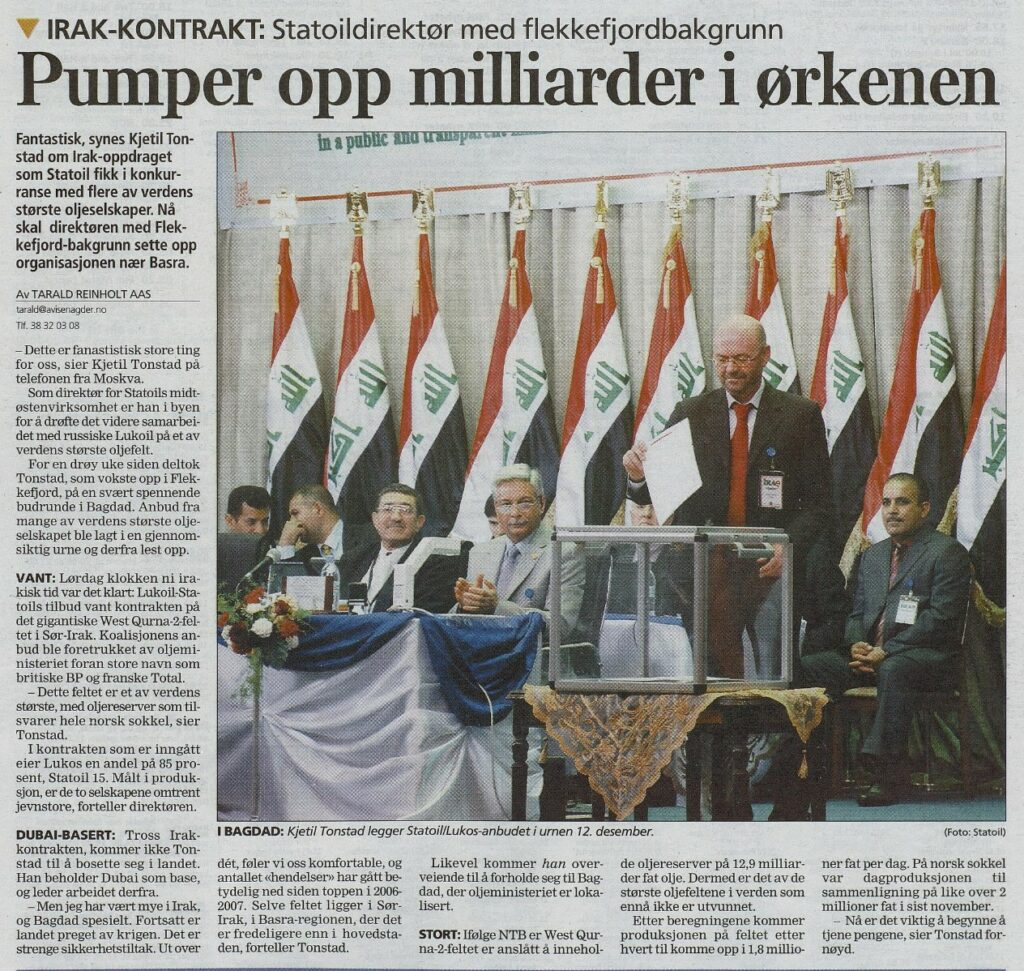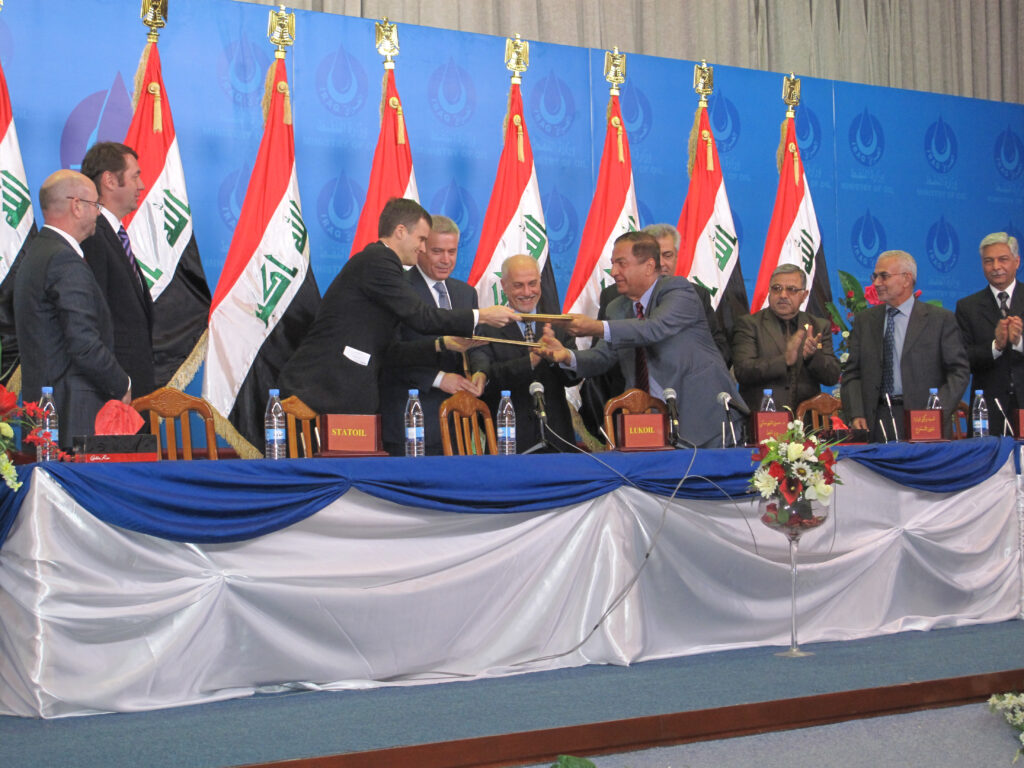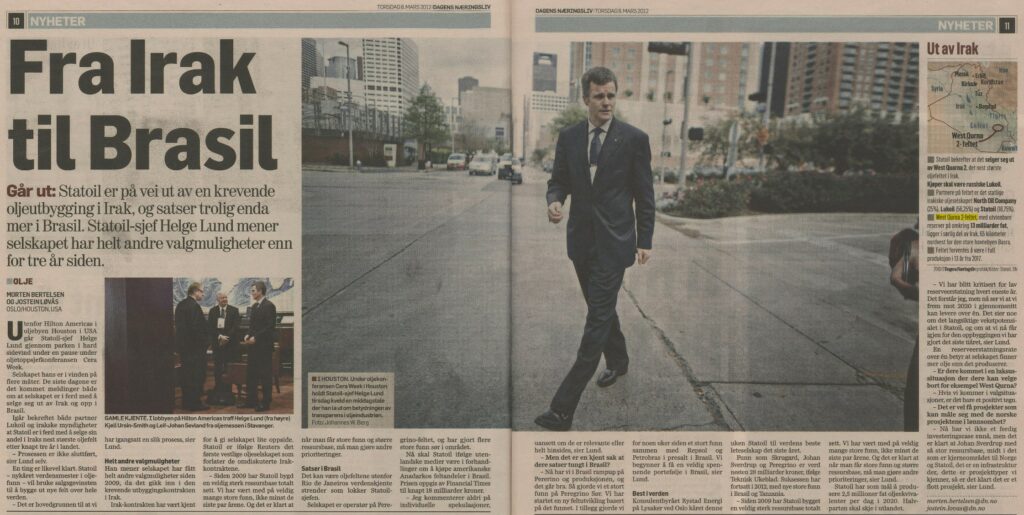Intermezzo in Mesopotamia

After a coup deposed the monarchy in 1958, Iraq has been a republic. During the 1960s and 1970s, its economy grew phenomenally because of increased revenues from oil.
The country nationalised its petroleum resources in 1972. US, British, Dutch and French oil companies who were pursuing oil production there were thrown out. Instead of foreigners taking bulk of the financial gain, the Iraqi government instituted a series of reforms which benefitted the population.
When war broke out with Iran in 1980, big resources were devoted to the fighting, developments ceased and infrastructure – particularly in the south – was damaged. Peace returned at a time when oil prices were low, and rebuilding the petroleum sector proved difficult. Much of the blame was laid at Kuwait’s door for overproduction, which provided the rationale for Iraq’s invasion of its neighbour in 1990.[REMOVE]Fotnote: https://snl.no/%C3%98konomi_og_n%C3%A6ringsliv_i_Irak.
The USA, which depended on imported Kuwaiti oil, forced Iraq out and the country was subjected to international sanctions. These hit the Iraqis hard. After Saddam Hussein’s dictatorship was toppled by the Americans in 2003, Iraq was afflicted by sectarian conflict. The Shia Muslim and Kurdish parties won a majority of votes in the first free elections in 2005, while the Sunni Muslims who had previously wielded all power lost much of their political influence. That contributed to an upsurge of Sunni extremism, and eventually to the establishment of Islamic State (IS). Bombings became daily fare in Baghdad.
Despite violence and terrorism in a divided country, the Iraqi authorities sought to get the nation back on its feet. That included opening the doors in 2003 to western oil companies for help in building up petroleum production capacity.
Oil auction in Baghdad
Statoil first participated in the second of the subsequent bidding rounds in December 2009. Forty-four oil companies were qualified to bid on the four fields included.
The bid system was based on paying the companies for the oil they produced above a specified target. Bidders offered a certain price per barrel, and estimated how many barrels per day they would produce. The company submitting the cheapest bid won. Each of the winners was also charged a signature bonus of USD 100-500 million.[REMOVE]Fotnote: Dagens Næringsliv, 21 October 10, “Lisensrunde i Irak ferdig”.
On the first day of the round, Statoil submitted a bid for the Halfaya oil field together with Russia’s Lukoil, but lost to a consortium headed by the China National Petroleum Corporation (CNPC) and including France’s Total and Petronas from Malaya.[REMOVE]Fotnote: E24, 11 December 2009, “Budkrigen i gang: Statoil tapte i Irak”.
However, the following day proved a complete success. Lukoil and Statoil won their bid for West Qurna 2, one of the world’s largest oil fields. It lies in southern Iraq, close to the confluence of the Tigris and Euphrates rivers and west of Basra.
The partners offered USD 1.15 per barrel after reaching the production target of 120 000 barrels per day compared with an estimated daily plateau production of 1.8 million. Total, which had bid USD 1.72 per barrel, claimed the Lukoil-Statoil price was ridiculously low.[REMOVE]Fotnote: Teknisk Ukeblad, 18 December 2009.
Statoil believed there was nothing to worry about. According to Torgeir Kydland, the company’s vice president for Eurasia, the Middle East and Asia, it had collaborated with the Iraqi government for five years through joint field studies and training of local personnel. Although the area was risky, he was confident that an organisation could be established to develop the project in a safe and responsible manner.[REMOVE]Fotnote: Nettavisen, 12 December 2009, “Statoil inn i kontroversielle Irak”.
Plans called for drilling to begin on West Qurna 2 in 2011, with production starting in late 2012. The field development programme included further seismic data acquisition and the drilling of more than 500 wells. Oil from the reservoir was high-quality. It also yielded associated gas, which Shell would receive.[REMOVE]Fotnote: Teknisk Ukeblad, 18 December 2009, “Slik kom Statoil inn i Irak”.

Contract for 18.75 per cent
CEO Helge Lund was present in Baghdad on 1 February 2010 to sign the contract. This ran for 20 years, with an option for a further five. The parties to the deal were Iraq’s state-owned South Oil Company and a consortium of contractors comprising state-owned North Oil Company (25 per cent), Lukoil (56.25 per cent) and Statoil (18.75 per cent).[REMOVE]Fotnote: Teknisk Ukeblad, 1 February 2010, “Irak-avtalen underskrevet i Bagdad”.
Clauses in the contract ensured that the oil companies would not suffer any loss if the government, for one reason or another, imposed a level of production below the planned level.
Some 20-30 Statoil employees were to help develop West Qurna 2 together with Lukoil personnel who had experience of field development on land. In addition to contributing expertise on improving the field’s recovery factor, Statoil hoped that Norwegian subcontractors would be interested in participating.[REMOVE]Fotnote: Teknisk Ukeblad, 18 December 2009, “Slik kom Statoil inn i Irak”.
A third Iraqi licensing round was held as early as October 2010, this time covering three gas fields. Despite being one of 13 prequalified companies, Statoil decided to pass on this occasion – even though the signature bonus had been dropped to make the fields more attractive.[REMOVE]Fotnote: Dagens Næringsliv, 21 October 2010, “Lisensrunde i Irak ferdig”.

Too tough?
No lack of warnings accompanied Statoil’s engagement in Iraq. Øystein Noreng, a professor at the BI Norwegian Business School, maintained that the company was taking too big a risk. Iraq had yet to put a new Petroleum Act in place, and it was therefore uncertain which legislation would apply for taxation and other issues. An election was scheduled in the year after signing the contract, and its outcome could suddenly alter the operating parameters.
Nevertheless, Noreng did not think the agreement would be cancelled regardless of which government took office. It was far too beneficial for Iraq. Increasing oil production would boost national revenues and contribute to recovery.
Land mines were another problem after the wars with Iran, Kuwait and the USA. Statoil was fully aware of the need to clear undetonated munitions, but lacked a full overview of their scope.[REMOVE]Fotnote: Tu.no, 18 December 2009, “Alt er risikofylt i Irak”.
Local dissatisfaction
However, the company had not expected that the field installations would be attacked by locals – although Lukoil was prepared for this.
West Qurna 2 lies in part of Basra province occupied by nine different tribes. Oil projects in the area displaced many local farmers, and unemployment was high – creating disappointment that petroleum activity did not produce more jobs. Farmers compulsorily relocated were dissatisfied with the compensation they received.
On the evening of 11 August 2011, a group of local men tried to force their way through the eastern entrance to the West Qurna 2 area. Some claimed that they wanted work, others that they were attacking. In any event, the Iraqi oil police protecting the installations fired at the intruders. The exchange of shots continued for about 25 minutes, but nobody was killed.
A representative of Norwegian Church Aid claimed that the locals felt unfairly treated by the government and the oil companies. Although Statoil and Lukoil sought to show corporate social responsibility (CSR), this was of little help if they lacked local knowledge and a close dialogue with the community. Such interaction was very difficult to achieve under a security regime which relied on armoured vehicles and a large force of guards for even the smallest transport assignment.[REMOVE]Fotnote: Teknisk Ukeblad, 25 August 2011, “Skuddveksling på Statoil-anlegg i Irak”. According to Statoil’s own health, safety and environmental (HSE) rules, it was too unsafe for Norwegians to visit the field facilities. But local workers could reside there. That represented a quandary.
Another dilemma which affected the farmers was the production method used to improve recovery. This involved injecting water into West Qurna 2 and five of the other new fields in the area. Consumption was so heavy that it would affect the water level in the Tigris and have unclear consequences for farming. Exxon was responsible for this injection project.
A further source of uncertainty was the disposal of the gas produced. Flaring it through lack of sales opportunities would conflict with Statoil’s own standards.[REMOVE]Fotnote: Hatlestad, Helge, 2021, Femti år med oljeproduksjon: min historie.
Given that development of the field was way behind schedule and that it was questionable whether USD 1.15 per barrel produced would give an adequate return in accordance with the requirements set by Statoil for its projects, the warning lights began to burn brightly for the corporate management.
Exit Iraq
Rumours that the company would sell out of Iraq were confirmed in March 2012. Lukoil was willing to buy its stake in West Qurna 2. Iraq had never been part of Statoil’s core business, Lund maintained. It was not an operator, and had always had opportunities to make a rapid exit. This involvement had been very demanding for the company, with security, profitability and bureaucracy all creating problems.[REMOVE]Fotnote: Stavanger Aftenblad, 7 March 2012, “Statoil bekrefter Irak-exit”. Instead, Statoil would devote its resources to projects in Norway and the Gulf of Mexico, which were attractive areas at the time.[REMOVE]Fotnote: Teknisk Ukeblad, 3 February 2012, “Statoil ut av Irak”.

